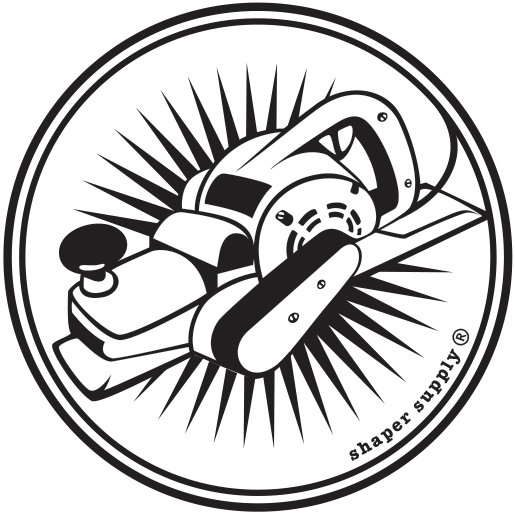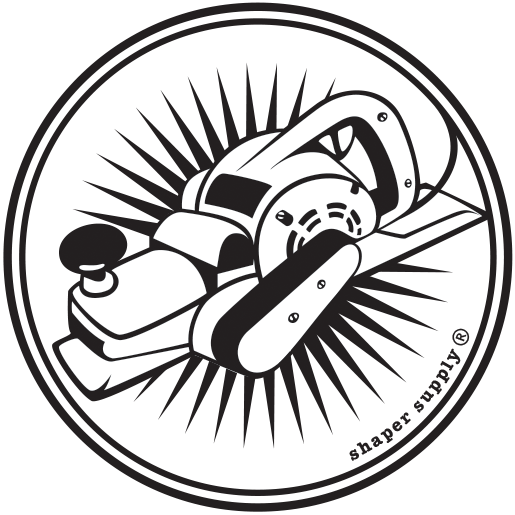Acetone
A cleaning fluid used to remove uncured resin.
Additive
Addedto resins to change characteristics, such as ultraviolet cure, improve sand ability.
Aramid Fibers
Used to achieve high-strength, high-modulus reinforcement in composites. Most closely related to Kevlar.
Bi-Directional Fiberglass
Strands are laid at right angles to each other, a directional pattern which gives maximum product strength in two planes. Also called Bi-Axial or X-Glass.
Belly
Used to refer to the contour bottom of a surfboard – a rolled convex bottom.
Blank
The foam core of a surfboard which is shaped before the fiberglassing process. The most common types are Polyurethane (PU) and Expanded Polystyrene (EPS).
Cab-o-sil
Thickening agent that can be added to polyester and epoxy surfboard resins. Typically used as a filler for ding repairs, although now Qcel is more widely used as its easier to sand.
Carbon Fiber
A strong, stiff, thin fiber of nearly pure carbon, made by subjecting various organic raw materials to high temperatures, combined with synthetic resins to product this strong, lightweight material.
Catalyst
Catalyst (MEKP) is the initiator that causes the chemical reaction that turns a liquid polyester resin into a solid.
Cant
Cant is the angle of the fin relative to the bottom of the board. Surfboard rail fins are canted slightly outward, typically between 3 – 9 degrees.
Cure / Curing
Curing refers to the toughening or hardening of a polymer material by cross-linking of polymer chains. When the additives are activated by ultraviolet light, the process is called UV-Cure.
Cutlap
A method used in laminating a surfboard, where the surfboard is taped off to cleanly cut off overlapping fiberglass. Typically used with tints/pigments or volan fiberglass.
Deck
The deck is the top of a surfboard (the portion the surfer lays on while paddling).
Delamination
Separation of fiberglass layer from the foam.
Ding
Damaged area on a surfboard.
E-Glass
The most commonly used type of surfboard fiberglass. The name is short for Electrical Glass as it was initially used for electrical applications.
Epoxy Resin
Epoxy resins are a class of reactive polymers which contain epoxide groups. Epoxy resins are commonly used for glassing EPS foam but are compatible with both EPS and PU foam.
EPS Foam
Expanded Polystyrene is a type of surfboard foam core. It is very lightweight compared to other foam types and must be glassed with epoxy resins.
Exothermic Heat (Exotherm)
Heat given off by resin during the curing process.
Fin Rope / Roving
After lamination, fin rope is soaked in resin and placed along the base of glass-on fins to provide support. It is then covered with several layers of fiberglass bonding fins to the laminate layer.
Fillers
Materials added to resins to thicken or change its density.
Fish Eye
A circular dimple in a resin topcoat usually caused by some type of contamination (oil, dust, etc).
Freelap
A method used in laminating a surfboard – used typically on clear boards. The fiberglass is lapped to the bottom of the board without masking tape.
Gel Time
Time from when catalyst is added to resin until the resin begins to harden or gel.
Gloss Resin
A specialized resin that dies very hard and allows sanding with high-grit sandpapers. Can then be polished to a high-gloss finish.
Hardener
Can refer to MEKP catalyst or part of an epoxy resin system.
Hot Coat
A topcoat of resin applied to the fill weave of the laminate.
Kick
- When resin begins to harden.
- Increase of a rocker curve towards the nose or tail.
Lamination (Laminate)
The process of applying fiberglass to a surfboard with resin.
Laminating Resin
A resin that was formulated to bond cloth (fiberglass, carbon, etc) to foam, wood or other fiberglass.
MEKP
Methyl ethyl ketone peroxide is a catalyst used to harden polyester resins.
Pigment
A resin colorant that is added typically during the lamination process. Pigments can be both opaque and transparent. The surf industry has made up a term “Tint” for transparent pigments, but this term is not used anywhere else in the composites industry.
Planer
A power tool used to shape foam blanks.
Polyester Resin
The most common type of surfboard resin. Contains styrene and cannot be used with EPS foam.
Polyurethane Foam
The most common type of surfboard foam used worldwide. Compatible with both Polyester and Epoxy Resins.
Post Cure
Obtaining a more complete cure by putting the object in a space with elevated temperatures.
Q-Cel
The most commonly used filler used as a resin thickener in ding repair. Q-Cel sands easier than Cab-o-sil, but Cab-o-sil has superior flex characteristics.
Rocker
The bottom curve of a surfboard from nose to tail. Typically measured along the stringer.
S-Glass (S-Cloth)
A type of fiberglass that has superior tensile strength than E-glass. S-Glass is said to have 10-30% more tensile strength per weight, but s-glass is stiff and can be difficult to laminate around rails. Usually, S-Glass is used in the sandwich layer on the deck, and then capped with E-Glass or Warp.
Sanding Resin
A type of resin that consists of A Laminating Resin base with Surfacing Agent added. Sanding Resin is used during the top coat / hot coat and sands easily.
Styrene
Used to thin polyester resins and can also be used as a carrier for other additives like UV Powder.
Surfacing Agent
A wax in styrene solution that causes Laminating Resin to dry tack-free.
Tint
Not proper composites terminology. See Pigment definition.
Toe-In
Fin placement relative to the stringer. Rail fins typically have a toe-in of up to ¼”.
UV Powder / UV Catalyst
Can be added to polyester and works as a photo-initiator to catalyze the resin via ultraviolet light (sun light).
Volan
A traditional surfboard fiberglass finish that was used on many of the early surfboards shaped in the 50’s and 60’s. Volan fiberglass shows a slight greyish/green color.
Warp Glass
Warp fiberglass has more strands running lengthwise than horizontally. This provides more buckling resistance and is a top-choice for stringerless boards.


